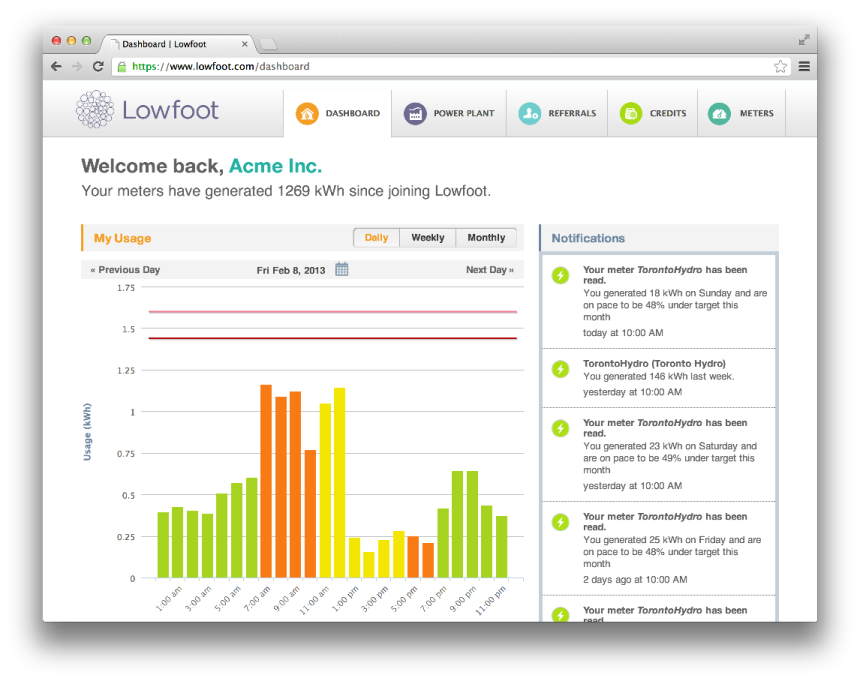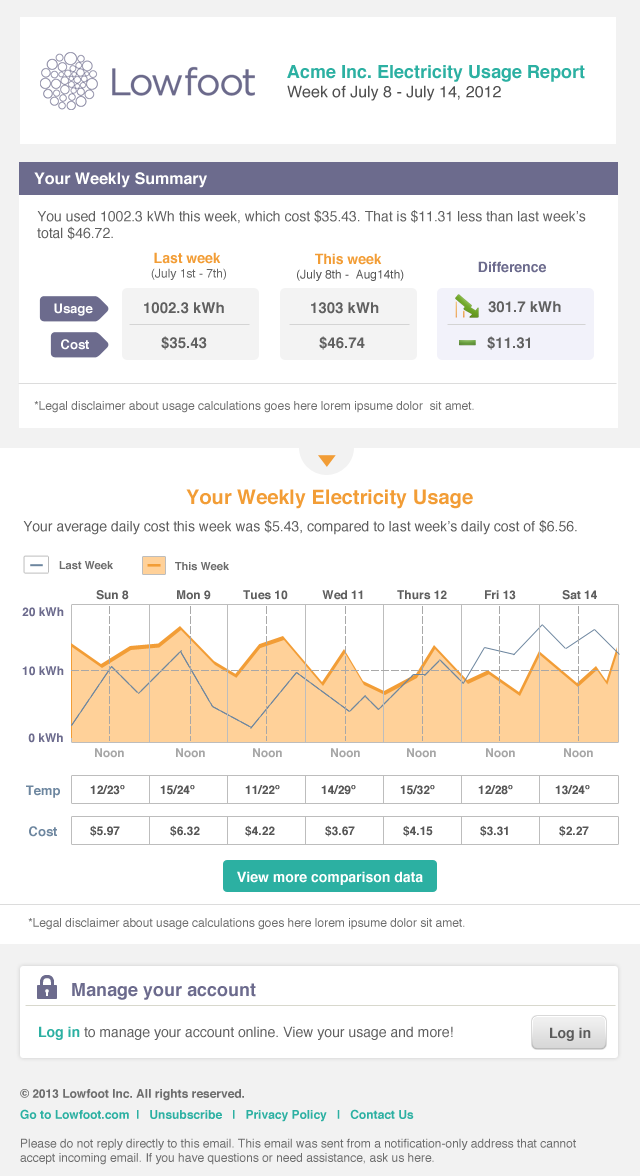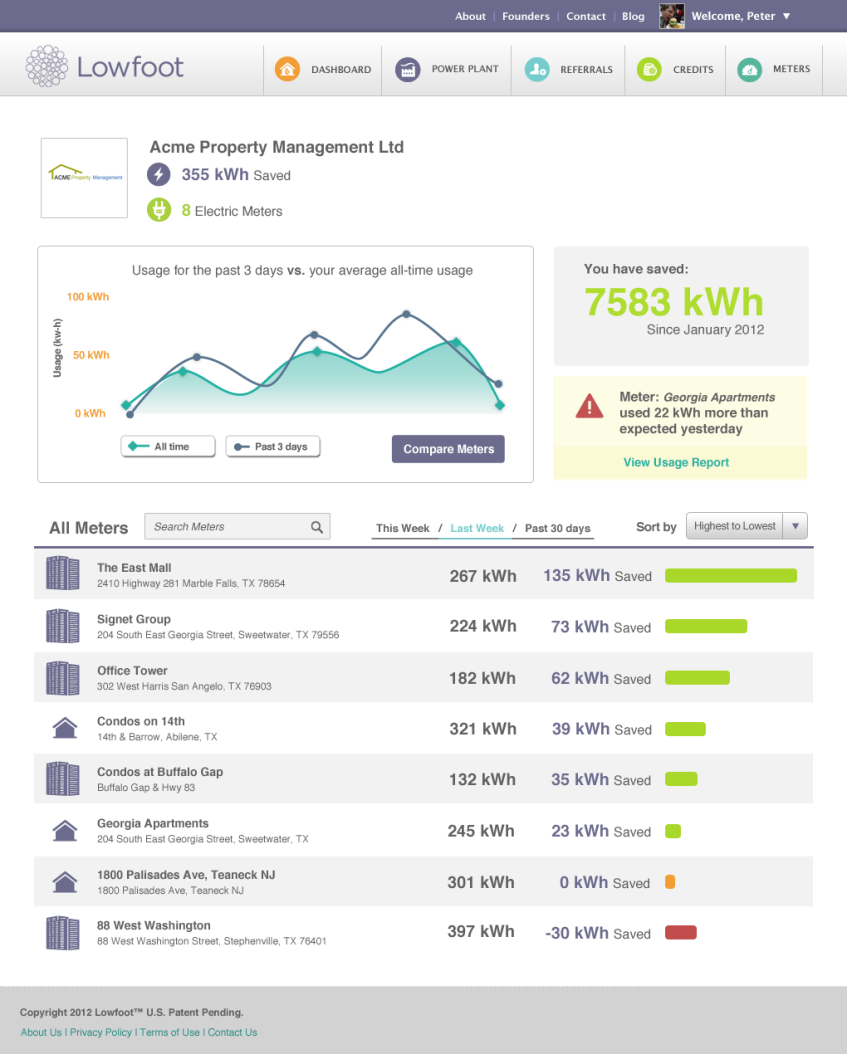
|
March 2013 |
[an error occurred while processing this directive] |
|
Reducing Energy and Environmental
Footprint |
Philip Playfair, CEO, Andrew Roehr, CTO, Lowfoot, Inc. |
| Articles |
| Interviews |
| Releases |
| New Products |
| Reviews |
| [an error occurred while processing this directive] |
| Editorial |
| Events |
| Sponsors |
| Site Search |
| Newsletters |
| [an error occurred while processing this directive] |
| Archives |
| Past Issues |
| Home |
| Editors |
| eDucation |
| [an error occurred while processing this directive] |
| Training |
| Links |
| Software |
| Subscribe |
| [an error occurred while processing this directive] |
According to the US
DOE’s Building Energy Data Book, the United States
buildings sector accounted for about 41% of primary energy consumption
in 2010. That was more than transportation and industry, 44% and 36%,
respectively. The four largest end uses in that year were space
heating, space cooling, water heating, and lighting. They represented
about 70% of site energy consumption.
With the economy recovering, building of commercial space, in terms of mid- and large-scale office towers to malls and multi-unit housing developments, is expected to accelerate significantly. Going along with development is higher energy consumption. Growth in building sector energy consumption is expected to increase as much as 31% by 2035. In many instances, buildings will meter space differently, and move away from tower consumption billing toward individual unit billing.
As a result, the
drive today is to create smart buildings as part of a
strategy to reduce energy usage from the outset and going
forward. This is perhaps best seen in the Leadership in Energy
and Environmental Design or LEED program, a voluntary set of guidelines
to be used in building energy efficient structures. A more
activist approach is shown in the California “Net Zero Energy”
objectives for commercial and residential buildings that “no net
purchases from the electricity or gas grid” with a path to 100% new
construction compliance by 2030. However, for the existing
commercial inventory, it is often focused on adding new technology
(e.g., system controls), building modifications, new materials or
improved systems management, in order to achieve premise energy
reduction. While these efforts are making a significant impact on
reducing per-capita (or per sq ft) consumption, it still does not solve
the problem of the “Peak”. (For more information about California’s Net
Zero Energy Plan, visit:
http://www.cpuc.ca.gov/NR/rdonlyres/6C2310FE-AFE0-48E4-AF03-530A99D28FCE/0/ZNEActionPlanFINAL83110.pdf.
Electric system
“Peaks” occur when demand is high, and are a normal,
everyday occurrence, often in response to weather. Utilities plan
for the peak and many regulators require electric generation and
infrastructure to be built with spare capacity to accommodate
consumption events beyond the design peak, in some cases keeping 10% –
15% of their capital deployed idle, waiting for the peak
moment. When those peaks arrive, utilities and grid
operators declare a “scarcity event”, and “demand response” programs
kick in where commercial building owners may find themselves asked to
shut down half their elevators or turn off banks of lights or otherwise
curtail consumption. In some cases, power is interrupted, or
localized rolling “brownouts” can occur, often damaging expensive
equipment and decreasing worker productivity. For large
commercial and industrial complexes, which often have sophisticated
premise Energy Management Systems, these events can be not only
survivable, but also profitable by selling their measured demand
reduction back to the grid.
With the broad
installation of Smart Meters, small/mid-sized commercial
and industrial customers as well as residential customers can begin to
participate in the energy eco-system not merely as a ratepayer, but as
a conscious consumer with choice. These customers represent a
significant and controllable load for utilities, and the introduction
of Smart Meter technology enables them to participate in the same kind
of load shifting or load reduction efforts as industry.
Lowfoot’s technology platform gives the owners and managers of small
business centers, shopping malls and corporate office towers that have
smart metering in each leased unit, the ability to reward reductions in
energy consumption both at the unit level and facility-wide.
Tenants can choose to reduce consumption as they see what their
activities cost.

Figure 1: Detailed graphs of usage at specific meters.
This “choice” model, which does not require initial capital investment by the property owner or utility customer, relies on commercial incentives to quickly make a difference. It is a new kind of “Demand Response”, available broadly, executed inexpensively. Lowfoot technology has huge implications for managers who want to optimize their energy pricing and reinforce tenant relations with a value-added program.
According to Pike
Research, the majority of commercial customers
engaging in demand response programs have been large businesses and
institutions. However, utilities, grid operators, and curtailment
service provides are now looking at small and medium-sized businesses
and institutional customers. These groups account for a significant
number of facilities and sites that can contribute a considerable
amount of load curtailment during a peak event. In addition, Pike
Research forecasts that the number of commercial facilities
participating in demand reduction programs will rise more than double,
to approximately 1.5 million sites by 2018.
Our technology has
two major components. The first is Customer
Engagement. We provide daily or weekly “Action Alerts” to
customers that allow them to set a baseline for managing their energy,
and then showing day-by-day how they are doing against that
baseline. Leveraging Email, SMS Text and Social Media to reach
end users, the system is highly flexible and allows customers, or
tenants, to be notified when there is a need for them to reduce their
consumption.
In short, Lowfoot’s technology allows a wide-range of malls, mid-sized and smaller automated buildings to participate in demand response programs. When a demand response “incident” occurs, participating members are notified to reduce their usage during a specific period of time on a specific day for a set price. After the incident the usage reduction is measured and verified for each participant using our proprietary bench-marking algorithms.

Figure 2: Weekly summary email comparing usage across weeks
The second component is Facility Management. Lowfoot can provide a way for property managers to aggregate the demand of the units within their buildings, and even compare building performance across their portfolio. As facility owners invest in retrofits, this gives them an historical record of consumption that also allows them to see the real benefits of, for example, new windows, lighting, or other infrastructure energy improvements quickly. This feedback can help them make more informed decisions around the real cost benefits of energy retrofits and innovation.

Figure 3: Energy
Dashboard for
managing electricity usage across
multiple properties.
[an error occurred while processing this directive] The comparison tools built into this product allow property owners to monitor either daily or weekly usage at all of their facilities. For owners with multiple, similar type facilities, the application can help identify anomalies between these properties. Lowfoot works with any kind of smart meter data and can help multinational firms track their electricity, gas and water usage around the world.
For organizations that are developing or have a corporate sustainability mission, the technology can be used as a tool to organize a reduction scheme amongst employees and customers. For utilities and retail energy providers, it can be used to help build relationships with customers by providing an easy to use tool that helps customers leverage value from their smart meter data.
Building
development has numerous impacts on the environment, from the
obvious of carbon dioxide emissions to the less obvious but potentially
more critical issue of potable water consumption for generation
cooling. Today, approximately 40% of carbon dioxide emissions
come from energy use in buildings. This will only grow over time. In
addition, it is estimated by the DOE that cutting energy use in U.S.
buildings by as little as 20% can save $80 billion a year. In
2005, the US Geological Survey report on water consumption tells us
that thermoelectric-power withdrawals accounted for 49 percent of total
water use, 41 percent of total freshwater withdrawals for all
categories, and 53 percent of fresh surface-water withdrawals.
Perhaps most alarming is that the increase in electric/water
consumption, which tracks economic growth, is greatest in the South and
Southwest United States, areas in which water is already scarce.
For building
owners and managers, Lowfoot can track energy costs, water
use and carbon impact, improve understanding of usage patterns and help
motivate reductions. Our product can also help tap the general
rising
awareness of these issues and concerns of tenants and their customers,
making buildings more attractive to renters and buyers. Finally,
in an energy-constrained world that is driven by demand and price, it
makes sense to look not only at technology and techniques but also
changing energy behavior as a tool to better manage consumption. For
more information about Lowfoot and what it offers multi-tenant property
owners with automated buildings, visit www.lowfoot.com.
About the Authors
 Philip Playfair,
CEO, Lowfoot, Inc.
Philip Playfair,
CEO, Lowfoot, Inc.
Philip Playfair, Founder and CEO, is a proven champion and developer of
utility software solutions. He spent nine years building, developing
and selling Advanced Utility Systems, a utility billing software
company. Prior to Advanced, Playfair oversaw the design,
development and rollout of the first electoral data management system
in Canada that overlaid electronic voter registration, complex
demographics data, polling data and automated data collection.
 Andrew Roehr, CTO. Lowfoot, Inc.
Andrew Roehr, CTO. Lowfoot, Inc.
Andrew Roehr is CTO for Lowfoot, Inc. He has more than 25 years of
experience with technology and the Power and Utilities industry. Most
recently, he was a Managing Director with Pricewaterhouse Coopers, LLP
where he oversaw their “Smart Energy” practice in the US and their
Global Center of Excellence. Prior to this, he was VP of Smart
Energy – North America for Capgemini.
[an error occurred while processing this directive]
[Click Banner To Learn More]
[Home Page] [The Automator] [About] [Subscribe ] [Contact Us]